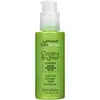What's inside
What's inside
 Key Ingredients
Key Ingredients

 Benefits
Benefits

 Concerns
Concerns

 Ingredients Side-by-side
Ingredients Side-by-side

Water
Skin ConditioningIsononyl Isononanoate
EmollientIsohexadecane
EmollientCyclopentasiloxane
EmollientGlycerin
HumectantCyclohexasiloxane
EmollientCetearyl Olivate
Xanthan Gum
EmulsifyingCetearyl Alcohol
EmollientSorbitan Olivate
EmulsifyingPhenoxyethanol
PreservativeVaccinium Myrtillus Fruit/Leaf Extract
AstringentMethylparaben
PreservativeSaccharum Officinarum Extract
MoisturisingEthylparaben
PreservativePropylene Glycol
HumectantAscorbyl Glucoside
AntioxidantCitrus Limon Fruit Extract
MaskingCitrus Aurantium Dulcis Flower Extract
Skin ConditioningTetrasodium EDTA
Acer Saccharum Extract
Skin ConditioningButylene Glycol
HumectantPanax Ginseng Root Extract
EmollientPotassium Hydroxide
BufferingMorus Alba Leaf Extract
Skin ConditioningPropylparaben
PreservativeWater, Isononyl Isononanoate, Isohexadecane, Cyclopentasiloxane, Glycerin, Cyclohexasiloxane, Cetearyl Olivate, Xanthan Gum, Cetearyl Alcohol, Sorbitan Olivate, Phenoxyethanol, Vaccinium Myrtillus Fruit/Leaf Extract, Methylparaben, Saccharum Officinarum Extract, Ethylparaben, Propylene Glycol, Ascorbyl Glucoside, Citrus Limon Fruit Extract, Citrus Aurantium Dulcis Flower Extract, Tetrasodium EDTA, Acer Saccharum Extract, Butylene Glycol, Panax Ginseng Root Extract, Potassium Hydroxide, Morus Alba Leaf Extract, Propylparaben
Butyl Methoxydibenzoylmethane 3%
UV AbsorberHomosalate 5%
Skin ConditioningEthylhexyl Salicylate 5%
UV AbsorberOctocrylene 7%
UV AbsorberWater
Skin ConditioningGlycerin
HumectantSilica
AbrasiveDimethicone
EmollientPEG-100 Stearate
Glyceryl Stearate
EmollientAmmonium Polyacryloyldimethyl Taurate
Emulsion StabilisingAscorbyl Glucoside
AntioxidantBenzyl Alcohol
PerfumingBenzyl Salicylate
PerfumingButylene Glycol
HumectantCapryloyl Salicylic Acid
ExfoliatingCaprylyl Glycol
EmollientCitral
PerfumingDicaprylyl Carbonate
EmollientDimethicone/Vinyl Dimethicone Crosspolymer
Skin ConditioningDipropylene Glycol
HumectantDisodium EDTA
Parfum
MaskingGeraniol
PerfumingLimonene
PerfumingLinalool
PerfumingMyristic Acid
CleansingNymphaea Alba Flower Extract
Skin ConditioningPalmitic Acid
EmollientPhenoxyethanol
PreservativePhenylethyl Resorcinol
AntioxidantSodium Hyaluronate
HumectantSodium Hydroxide
BufferingSodium Palmitoyl Proline
Skin ConditioningSteareth-100
Gel FormingStearic Acid
CleansingT-Butyl Alcohol
PerfumingTocopherol
AntioxidantXanthan Gum
EmulsifyingButyl Methoxydibenzoylmethane 3%, Homosalate 5%, Ethylhexyl Salicylate 5%, Octocrylene 7%, Water, Glycerin, Silica, Dimethicone, PEG-100 Stearate, Glyceryl Stearate, Ammonium Polyacryloyldimethyl Taurate, Ascorbyl Glucoside, Benzyl Alcohol, Benzyl Salicylate, Butylene Glycol, Capryloyl Salicylic Acid, Caprylyl Glycol, Citral, Dicaprylyl Carbonate, Dimethicone/Vinyl Dimethicone Crosspolymer, Dipropylene Glycol, Disodium EDTA, Parfum, Geraniol, Limonene, Linalool, Myristic Acid, Nymphaea Alba Flower Extract, Palmitic Acid, Phenoxyethanol, Phenylethyl Resorcinol, Sodium Hyaluronate, Sodium Hydroxide, Sodium Palmitoyl Proline, Steareth-100, Stearic Acid, T-Butyl Alcohol, Tocopherol, Xanthan Gum
Ingredients Explained
These ingredients are found in both products.
Ingredients higher up in an ingredient list are typically present in a larger amount.
Ascorbyl Glucoside is a stable form of Vitamin C. It is created by combining glucose from starch.
When applied to skin, Ascorbyl Glucoside turns into Ascorbic Acid.
Ascorbyl Glucoside is an antioxidant. Antioxidants help fight free-radicals, or molecules that may damage skin cells.
It can help to reduce redness, improve skin texture, reduce the effects of aging, reduce the visibility of dark spots, and brighten skin.
Read more about other types of Vitamin C:
Learn more about Ascorbyl GlucosideButylene Glycol (or BG) is used within cosmetic products for a few different reasons:
Overall, Butylene Glycol is a safe and well-rounded ingredient that works well with other ingredients.
Though this ingredient works well with most skin types, some people with sensitive skin may experience a reaction such as allergic rashes, closed comedones, or itchiness.
Learn more about Butylene GlycolGlycerin is already naturally found in your skin. It helps moisturize and protect your skin.
A study from 2016 found glycerin to be more effective as a humectant than AHAs and hyaluronic acid.
As a humectant, it helps the skin stay hydrated by pulling moisture to your skin. The low molecular weight of glycerin allows it to pull moisture into the deeper layers of your skin.
Hydrated skin improves your skin barrier; Your skin barrier helps protect against irritants and bacteria.
Glycerin has also been found to have antimicrobial and antiviral properties. Due to these properties, glycerin is often used in wound and burn treatments.
In cosmetics, glycerin is usually derived from plants such as soybean or palm. However, it can also be sourced from animals, such as tallow or animal fat.
This ingredient is organic, colorless, odorless, and non-toxic.
Glycerin is the name for this ingredient in American English. British English uses Glycerol/Glycerine.
Learn more about GlycerinPhenoxyethanol is a preservative that has germicide, antimicrobial, and aromatic properties. Studies show that phenoxyethanol can prevent microbial growth. By itself, it has a scent that is similar to that of a rose.
It's often used in formulations along with Caprylyl Glycol to preserve the shelf life of products.
Water. It's the most common cosmetic ingredient of all. You'll usually see it at the top of ingredient lists, meaning that it makes up the largest part of the product.
So why is it so popular? Water most often acts as a solvent - this means that it helps dissolve other ingredients into the formulation.
You'll also recognize water as that liquid we all need to stay alive. If you see this, drink a glass of water. Stay hydrated!
Learn more about WaterXanthan gum is used as a stabilizer and thickener within cosmetic products. It helps give products a sticky, thick feeling - preventing them from being too runny.
On the technical side of things, xanthan gum is a polysaccharide - a combination consisting of multiple sugar molecules bonded together.
Xanthan gum is a pretty common and great ingredient. It is a natural, non-toxic, non-irritating ingredient that is also commonly used in food products.
Learn more about Xanthan Gum